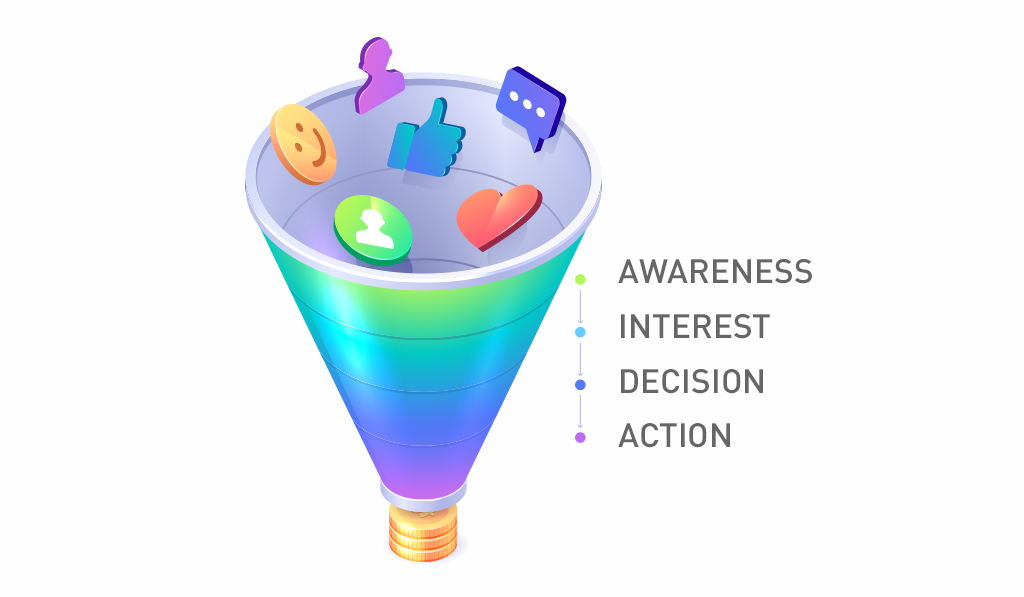 Glossary
Glossary
What is a conversion funnel?
Everything you need to know about the conversion funnel
In times like these, ecommerce is going through a boom and has become a real ally to the general public.
Brands have a great opportunity, however, it’s not as easy as it seems: people want to buy, there is a demand, but often, they don’t convert, why is that?
To answer that question, we need to look through each stage of the conversion funnel.
The conversion funnel or sales funnel – what is it?
As we mentioned in our post about personalisation, when a potential customer arrives on a page, they go through various steps before becoming a lead or finalising a purchase. This series of steps is known in the marketing world as the conversion funnel or sales funnel.
More specifically, the sales funnel refers to the steps that a client must follow on a website or online shop to reach a goal. Depending on the type of campaign, end goals can vary for the conversion funnel, and can go from gathering data to people subscribing or even completing a purchase (the most common goal).
One thing that should be made clear about the conversion funnel is its shape. Even though at the start there are many potential leads that will leave at different stages (from choosing a product, putting it in the cart, entering bank detail) until there are only a few left at the bottom who will buy.
Knowing at what stage clients stop with their purchase allows us to improve the process and this way, you ensure a bigger conversion number. You need to spot where potential customers are going and do what is necessary to stop them from leaving.
The different phases of the conversion funnel
As we said, the conversion funnel is the graphic representation of the different steps a customer takes, from being a possible lead all the way up to a buying customer that even recommends the product.
There are many different names for the stages the customers go through and different ways to order the conversion funnel, but these are the most common:
- Awareness: this is the first interaction between the potential customer and the brand. The communication goal at this stage is to attract the biggest number of people possible to your website.
- Interest: at this point, the client already knows you, now you have to gain their trust little by little and awaken their interest.
- Engagement: The goal here is for the user to spend as much time as possible on your page and create engagement. You need to keep them interested in your content, and make sure they look for it and visit it. This stage is normally when data is asked for to turn them into a lead and follow up on them.
- Conversion: this is a key moment in the conversion funnel. This is the point where the lead becomes a real client.
- Recommendation: once the sale is complete, you can try to get the client to recommend you and buy again. This is where retargeting starts.
ToFu, MoFu and BoFu Content and how to use it properly
Now that we’ve looked at the different stages of the conversion funnel, you need to know what actions you should take to lead your client from the start of the funnel all the way to the bottom.

1 TOFU (Top of the funnel): At the start of the conversion funnel, people barely know who you are and know much less about whether they need your products or not. For this, we should put in place informative content for them to get to know you. The main examples of this are blogs or webinars, which give valuable content that talks about you as an expert in your field and works to hook in any possible leads.
2 MOFU (Middle of the funnel): At this stage, in the middle of the conversion funnel, you should focus on generating leads. Offer much more specialised valuable content that provides real solutions such as infographics, ebooks or even success stories of people who recommend you and with whom the audience can identify. This is the ideal moment for lead nurturing, so the content must offer the possibility for the user to give you more information about them and their needs.
3 BOFU (Bottom of the funnel): Finally, the lead has decided to become a client, so the content can openly talk about the product or services offered, as well as the brand. This is the ideal time to launch promotions, discount coupons, free trials, demos or newsletters. Here we go from having a cold lead at the beginning of the conversion funnel to a warm lead, which is the one that is ready to buy or to be contacted and finalise the purchase.
The conversion funnel does not only work to help us understand our audience through a graphic representation, from a possible lead to one deciding to buy. The conversion funnel also allows us to analyse and optimise those stages that aren’t working and where there is a possible leak letting possible clients out. This way, you can make sure that there are more purchases, so if you have an ecommerce business, you already know what you have to do. Go out there and funnel!


